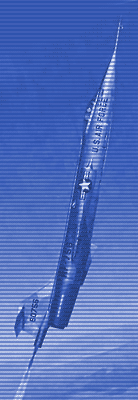The Mission > home

|
|
|
|
|
|
 |
The Mission click on the links below for more of the story...
|
15 The End…Finis…QED!Bob Rushworth successfully flew to 112,000 feet on his only flight in the AST . He was a graduate engineer, had flown many hours of X-15 simulations and he had learned the difference between atmospheric and space flight in a number X-15 flights before he flew the AST. I was successful on every zoom that I flew while staying within what I knew was at least an analyzed flight envelope. Not until I intentionally, and inexcusably, exceeded the instrumentation limits, and that by a truly unreasonable margin, was I unable to succeed. I had far less experience and flying ability than Chuck. But I had what he lacked, which was modern and excellent formal training in instrument flying in high performance jets plus understanding of the new environment of space and control techniques for it, because I was a graduate aeronautical engineer and had studied space flight for six months in the Aerospace Research Pilots School. In fact, I think that the greatest tribute to the people who created the AST and the uncanny success that resulted from their combined effort was the fact that the airplane had so much margin of controllability and cockpit display capability that on my very first zoom, I was able to overcome the very serious wiring mistake that caused a critical situation for attitude control with the rocket thrusters, but there was margin enough for that. The AeroSpace Trainer became a pawn in a political game and/or a victim of a loss of an Air Force mission in space. In my opinion Chuck was one of the great test pilots of our time but proved he was out of his element in the AST. Those responsible for allowing his decision to fly were more responsible than he, and na´ve about space flight. In comparison, Jimmy Doolittle, who was arguably the greatest pilot and test pilot of all time had a PhD in Aeronautical Engineering from M.I.T. There is a point that should not be overlooked about the AST aircraft. That the people who conceived the AST and those that designed and fabricated it accomplished their goal magnificently under the conditions of existing technology, antique computers and minimal funding. One major difference between then and now was the computer. Today, truly unstable airplanes can and are made to react correctly, merely with a fly-by-wire system interjected as interface between pilot and airplane. That allows many advantages, even deriving performance benefits from instability, or gaining flight control by engine thrust-vectoring, for example. They had none of those benefits, little money, and no time to acquire new hardware but provided a machine that demanded only that pilots be skilled in test; disciplined enough to remain within the design boundaries, trained to understand the flight environment and its peculiarities and knowledgeable about the technical differences between aerial and space-flight. |
| previous section | next section |